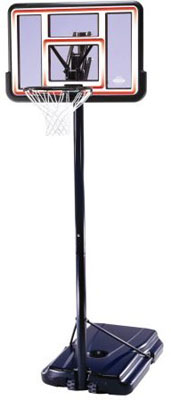Lifetime 1269 Pro Court Height Adjustable Portable Basketball System, 44 Inch Backboard
- List Price:
$199.99 - Sale Price: $156.32
- Amount Saved: $43.67
- Availability: Usually ships in 24 hours
$156.32
Feature
- 44" Shatterproof Fusion backboard is constructed of a shatterproof Polycarbonate playing surface
- Telescoping height adjustment mechanism adjusts from 7.5 to 10 feet
- Fade Resistant Graphics; 3-Piece steel pole is all-weather resistant
- Classic rim with all-weather nylon net
- Portable basketball system requires no cement - just fill up the base and play
Product Detail
- Product Dimensions: 34.5 x 44 x 8.3 inches; 55.8 pounds
- Shipping Weight: 55.8 pounds
- ASIN: B0015S9FPW
- Item model number: 1269
- Average Customer Review: Customer Reviews
Product Description
Amazon.com
 Lifetime's 1269 Portable Basketball System will adjust from 7.5 to 10 feet tall in six-inch increments. |
Key Features:
- Break-resistant acrylic playing surface
- High-impact, molded polyethylene frame
- Fade-resistant graphics
- Classic rim with welded steel net hooks
- Nylon net included
- Telescoping height adjustment allows you to adjust from 7.5 to 10 feet in 6-inch increments
- No tools required for assembly
- Powder coated rust-resistant finish
- 27-gallon portable base
- Fills with sand or water
- Rolls to desired location
Amazon.com Basketball System Buying Guide
With the high-quality construction of many portable basketball systems, turning your driveway into a basketball court can be as simple as hooking up your garden hose. But while a portable system may ultimately be your best choice, there are reasons you may want to consider an in-ground or wall-mount system before you decide.
In-Ground Systems
In-ground systems are permanently cemented into the ground--either via a bolt mounting kit or directly into the ground--and are generally more rigid and take up less space than portables. In-ground systems often require that you hire a professional to complete the task, but when the cement dries you'll have a hoop that can take punishing dunks with ease.
Many in-ground systems are height-adjustable, include removable post features that let you take the system down for off-season storage, and feature heavy-duty break-away rims. You'll also want to research the adjustable mechanisms on the systems, as there are several types to choose from. Some feature a counter-balance spring that lets you perform easy, one-hand adjustments while others may feature a sturdy, pneumatic system.
Wall-Mount Systems
Wall-mount systems can be mounted to the side of a house, a tall retaining wall, or a garage. Generally sturdier than portables, wall-mounts have the added advantage of optimizing your existing ground space for the court, since you won't take any space up with the base or pole. Not all systems include the necessary hardware, so make certain you add a mounting kit to your list.
Portable Systems
Portable systems require minimal installation and offer ultimate convenience. These systems generally feature a base that can be filled with sand or water to stabilize them and include wheels for portability. Although they are not as sturdy as in-ground or wall-mounted hoops, portables are simple to set up and can often be folded for convenient storage.
Backboard Considerations
Regardless of which system you choose, you'll want to brush up on Backboards 101. Most residential systems feature backboards made of acrylic, fiberglass, graphite, or various other composite materials. While clear acrylic gives the professional look and feel of glass, it is not as rigid as fiberglass or graphite. Some systems may offer steel or aluminum backboards, which are virtually vandal resistant, but don't offer the true rebounding action.
The regulation size of an NBA backboard is 72 inches wide and 42 inches high. Most portable hoops are 42 or 44 inches wide and 36 inches tall. In-ground systems tend to be a bit larger, with 54-inch and 60-inch widths being the most popular. While rectangular shaped backboards provide more bank shot opportunities, they are generally more expensive than the streamlined fan-shaped board.





